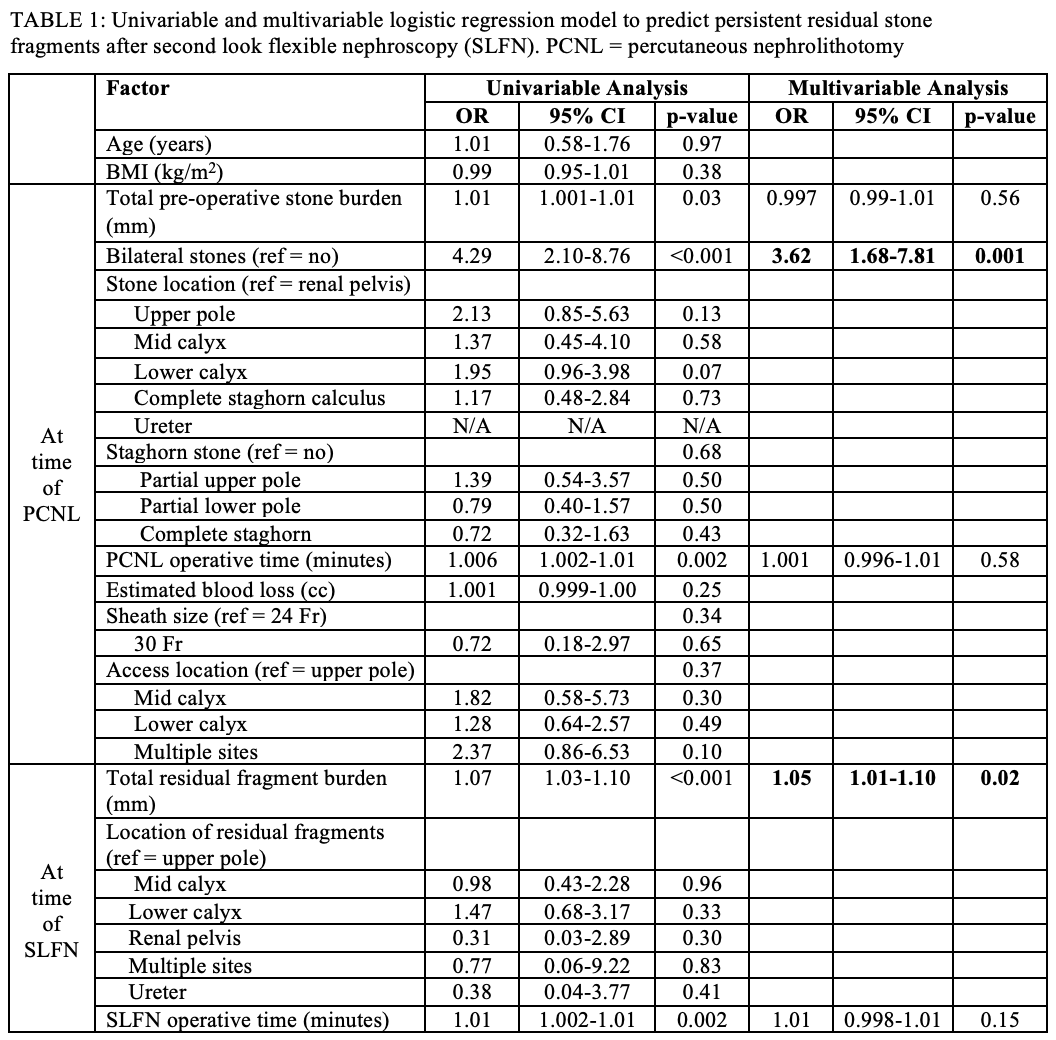Back
Poster, Podium & Video Sessions
Moderated Poster
MP14: Stone Disease: Surgical Therapy (including ESWL) I
MP14-15: Predictors of Successful Second Look Flexible Nephroscopy after Percutaneous Nephrolithotomy
Friday, May 13, 2022
2:45 PM – 4:00 PM
Location: Room 225
Jessica Dai*, Hersh Trivedi, Vineeth Kommidi, Brett Johnson, Jodi Antonelli, Margaret Pearle, Dallas, TX

Jessica C. Dai, MD
UT Southwestern Medical Center
Poster Presenter(s)
Introduction: Second look flexible nephroscopy (SLFN) after percutaneous nephrolithotomy (PCNL) improves stone free rates. However, even after SLFN, residual fragments (RFs) may remain. We sought to determine patient, initial stone characteristics, and peri-operative parameters that might be associated with RFs after SLFN.
Methods: After IRB approval, we identified all patients at our institution who underwent PCNL and SLFN between 1/2016 and 5/2020. Those with nephrocalcinosis, no pre-operative CT, or no post-operative imaging after SLFN were excluded. Demographics, patient and stone characteristics and peri-operative parameters were extracted from the electronic medical record. Post-PCNL RF were identified on post-operative day 1 CT. Post-SLFN fragments were identified on either follow-up KUB or CT obtained within 3 months of PCNL. Although ultrasound was routinely obtained, determination of RFs was considered too unreliable to report. Univariate (UVA) and multivariable logistic regression analyses (MVA) were performed to identify predictors of persistent fragments on post-operative imaging.
Results: 254 patients underwent PCNL and SLFN, 201 of whom met inclusion criteria. Median size of the largest RF at the time of SLFN was 5 mm (IQR 2-8) and median cumulative RF stone burden was 8 mm (IQR 5-14). Most RFs were in the lower pole of the kidney (44.8%). Stone free rate after SLFN was 58% (n=116). Median cumulative stone burden on post-treatment imaging was 6.5 mm (IQR 4-12) and median size of the largest post-SLFN fragment was 5 mm (IQR 3-8). On UVA, larger total stone burden, bilateral stones and longer operative time at initial PCNL were associated with persistent post-treatment fragments, as well as greater total RF burden and operative time at SLFN (Table 1). On MVA, bilateral stone burden at initial PCNL and greater RF burden at time of SLFN were independent predictors of radiographically detected post-treatment fragments.
Conclusions: SLFN results in 58% of patients with RFs rendered stone free. Patients with initial bilateral stones prior to PCNL and greater RF stone burden at time of SLFN are more likely to have persistent post-treatment fragments, despite attempts at aggressive stone removal at initial PCNL and SLFN. Limitations include lack of uniform CT imaging post-treatment, which may underestimate persistent post-treatment RFs.
Source of Funding: None

Methods: After IRB approval, we identified all patients at our institution who underwent PCNL and SLFN between 1/2016 and 5/2020. Those with nephrocalcinosis, no pre-operative CT, or no post-operative imaging after SLFN were excluded. Demographics, patient and stone characteristics and peri-operative parameters were extracted from the electronic medical record. Post-PCNL RF were identified on post-operative day 1 CT. Post-SLFN fragments were identified on either follow-up KUB or CT obtained within 3 months of PCNL. Although ultrasound was routinely obtained, determination of RFs was considered too unreliable to report. Univariate (UVA) and multivariable logistic regression analyses (MVA) were performed to identify predictors of persistent fragments on post-operative imaging.
Results: 254 patients underwent PCNL and SLFN, 201 of whom met inclusion criteria. Median size of the largest RF at the time of SLFN was 5 mm (IQR 2-8) and median cumulative RF stone burden was 8 mm (IQR 5-14). Most RFs were in the lower pole of the kidney (44.8%). Stone free rate after SLFN was 58% (n=116). Median cumulative stone burden on post-treatment imaging was 6.5 mm (IQR 4-12) and median size of the largest post-SLFN fragment was 5 mm (IQR 3-8). On UVA, larger total stone burden, bilateral stones and longer operative time at initial PCNL were associated with persistent post-treatment fragments, as well as greater total RF burden and operative time at SLFN (Table 1). On MVA, bilateral stone burden at initial PCNL and greater RF burden at time of SLFN were independent predictors of radiographically detected post-treatment fragments.
Conclusions: SLFN results in 58% of patients with RFs rendered stone free. Patients with initial bilateral stones prior to PCNL and greater RF stone burden at time of SLFN are more likely to have persistent post-treatment fragments, despite attempts at aggressive stone removal at initial PCNL and SLFN. Limitations include lack of uniform CT imaging post-treatment, which may underestimate persistent post-treatment RFs.
Source of Funding: None


.jpg)
.jpg)